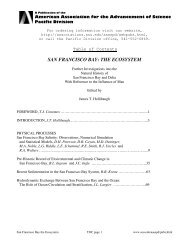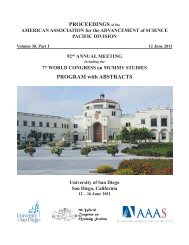Vol 31, Part I - forums.sou.edu ⢠Index page - Southern Oregon ...
Vol 31, Part I - forums.sou.edu ⢠Index page - Southern Oregon ...
Vol 31, Part I - forums.sou.edu ⢠Index page - Southern Oregon ...
You also want an ePaper? Increase the reach of your titles
YUMPU automatically turns print PDFs into web optimized ePapers that Google loves.
ABSTRACTS – Contributed Posters<br />
Avenue, Los Angeles, CA 90095; cahlos.an22@gmail.com,<br />
katelynn.barkley@gmail.com).<br />
Cisplatin (Cis) and Paclitaxel (Pac) are chemotherapy<br />
drugs used to stop cancer cell proliferation and N-Acetyl-<br />
Cysteine (NAC) is a supplemental drug used to supply<br />
nutrients to the body. Objective: To observe the synergistic<br />
effects of Cis and Pac combined with NAC, to treat pancreatic<br />
cancer stem cells (BXPC3s). Methods: BXPC3s were treated<br />
with four different concentrations (10, 20, 30, and 40 µg)<br />
of Cis, Pac, Cis+NAC (20µg), Pac+NAC (20µg). Cell death<br />
assay using flow cytometry were employed to examine the<br />
BXPC3s after a 24 hour treatment. Propidium Iodide (PI)<br />
was used because it can integrate within the cells that have<br />
a porous membrane, an indication of cell death, and allow<br />
quantification of dead tumor cells. Results: More PI was<br />
found in Cis treated BXPC3 than Pac treated BXPC3. The<br />
amount of PI decreased by 20% in Cis+NAC treated BXPC3<br />
when compared to Cis-only treated BXPC3 and increased by<br />
40% in Pac+NAC treated BXPC3 when compared to Paconly<br />
treated BXPC3. Conclusion: Cis is more effective at<br />
treating BXPC3s than Pac; however, the addition of NAC<br />
inhibited the killing effects of Cis while synergistically<br />
increasing the killing effects of Pac on BXPC3s. Discussion:<br />
Since Cis and Pac have negative side effects when used to<br />
treat patients, the addition of a supplement drug NAC might<br />
help to control such negative side effects without lowering<br />
the efficiency of the chemotherapy drugs. However, further<br />
research in vivo is needed.<br />
169 Do Human Multiple Myeloma Cells Express IL-6<br />
Family Inflammatory Cytokines DANIELLE HEDEEN*,<br />
DOLLIE LaJOIE, and CHERYL JORCYK (Department<br />
of Biological Sciences, Boise State University, 1910<br />
University Drive, Boise, ID 83725; daniellehedeen@u.<br />
boisestate.<strong>edu</strong>).<br />
Multiple myeloma (MM) is a cancer of the plasma cells,<br />
found in the bone marrow, which leads to the formation<br />
of multiple tumors in bone. Plasma cells arise from B<br />
lymphocytes, and produce immunoglobulins that help rid the<br />
body of infection. It is known that the inflammatory cytokine,<br />
Interleukin (IL)-6, is an important growth factor for human<br />
MM, and human MM cells are known to express IL-6. We<br />
hypothesize that other cytokines in the IL-6 family may also<br />
be expressed in human MM. For the model system, we are<br />
using three human MM cell lines (RPMI-8226, MM1.S,<br />
and MM1.R) grown in RPMI-1640 media with 10% FBS<br />
and penicillin-streptomycin. The secretion of IL-6-family<br />
cytokines by these three cell lines will be investigated by<br />
enzyme-linked immunosorbent assay (ELISA), reverse<br />
transcriptase polymerase chain reaction (RT-PCR), and<br />
Western blot analysis. Family member receptor expression<br />
will also be investigated by RT-PCR. Furthermore, we will<br />
investigate the effect of IL-6 family cytokines on proliferation<br />
in these MM cell lines, and vascular endothelial growth<br />
factor (VEGF) secretion by ELISA. Investigating the effects<br />
of IL-6 family inflammatory cytokines and their signaling<br />
in these cell lines will lead to a better understanding of MM<br />
biology and potentially identify novel therapeutic targets.<br />
170 Overexpression of SOX4 Leads to Down Regulation<br />
of UBC9, JOHANNA LEWIS* 1 , RUBY ENRIQUEZ* 1 ,<br />
MIN ZHANG 2 , and SHEN HU 2 ( 1 Howard Hughes Medical<br />
Institute Pre-College Science Education Program; 2 UCLA<br />
School of Dentistry, Division of Oral Biology and Medicine,<br />
10833 Le Conte Avenue, Room 63-070 CHS, Los Angeles,<br />
CA 90095; jjlewis46@gmail.com, rubyenriquez@live.com).<br />
Sex Determining Region-Y4 (SOX4) is a transcription<br />
factor, which plays an important role in embryonic<br />
development. It is composed of three regions, High Mobility<br />
Group box (HMG), Glycine Rich Region (GRR) and<br />
Serine Rich Region (SSR). SOX4 expression was found<br />
to be deregulated in many types of cancer. However, the<br />
underlying mechanism is still not clear. Objective: To study<br />
the effects of the overexpression of SOX4 in oral cancer.<br />
Methods: Sox4-FLAG plasmid was transformed into E.<br />
coli cells. Plasmid DNA was purified by Maxi plasmid<br />
DNA purification kit (Qiagen). The concentration of DNA<br />
is determined by nanodrop spectrometer and the size of<br />
plasmid is confirmed by agarose gel electrophoresis. The<br />
oral cancer cell line UM1 was used to overexpress SOX4.<br />
The overexpression of SOX4 is confirmed by Western blot<br />
analysis with anti-FLAG mouse monoclonal antibody and<br />
anti SOX4 mouse monoclonal antibody, respectively. The<br />
expression of Ubiquitin Conjugating Enzyme-9(UBC9),<br />
which plays an important role in metastasis, was detected<br />
with anti UBC9 rabbit polyclonal antibody. Results: SOX4<br />
is overexpressed in UM1 cells by introduction of SOX4-<br />
FLAG plasmid into the cells; the overexpression of SOX4<br />
in cell line UM1 resulted in the down regulation of UBC9.<br />
Discussion: Further research on SOX4 for a more precise<br />
outcome of its effects may result in a possible cure for oral<br />
cancer. Conclusion: Overexpression of SOX4 might limit<br />
metastasis via down-regulation of the expression of target<br />
proteins, such as UBC9, which have a role in metastasis.<br />
171 TCDD Treatment Suppresses Vitamin A Storage and<br />
Activates LX-2 Human Hepatic Stellate Cells, WENDY A<br />
HARVEY*, JALISA J ROBINSON, REILLY J CLARK,<br />
CALEB D HUANG, and KRISTEN A MITCHELL<br />
(Department of Biology, Boise State University, 1910<br />
University Drive, Boise ID 83725; wendyharvey@u.<br />
boisestate.<strong>edu</strong>).<br />
2,3,7,8-Tetrachlorodibenzo-p-dioxin (TCDD) is an<br />
environmental pollutant in the family of halogenated<br />
aromatic hydrocarbons. Exposure of rodents to TCDD has<br />
been shown to modulate retinol metabolism by decreasing<br />
hepatic retinyl esters, yet the mechanism by which this occurs<br />
has not been identified. In the present study, we used the<br />
97








